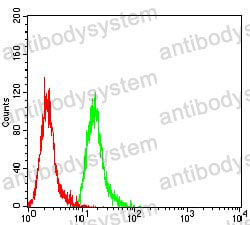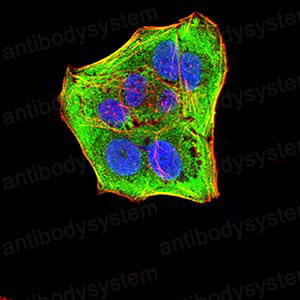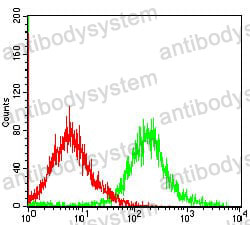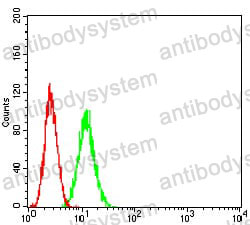Catalog No.
RHF11102
Species reactivity
Human
Host species
Mouse
Isotype
IgG2a
Clonality
Monoclonal
Tested applications
ELISA: 1:10000, FCM: 1:200-1:400, IF: 1:100-1:500
Target
Apoptotic protease Mch-2, Caspase-6, CASP-6, MCH2, CASP6
Concentration
1 mg/ml
Endotoxin level
Please contact with the lab for this information.
Purity
>95% as determined by SDS-PAGE.
Purification
Protein A/G purified from cell culture supernatant.
Accession
P55212
Applications
ELISA, FCM, IF
Form
Liquid
Storage buffer
0.01M PBS, pH 7.4, 0.05% Sodium Azide.
Stability and Storage
Use a manual defrost freezer and avoid repeated freeze-thaw cycles. Store at 4°C short term (1-2 weeks). Store at -20°C 12 months. Store at -80°C long term.
Clone ID
R3N38
iPSC-induced neurons with the V337M MAPT mutation are selectively vulnerable to caspase-mediated cleavage of tau and apoptotic cell death., PMID:39032719
Immune responses to Vibrio vulnificus formalin-killed vaccine and ghost vaccine in Scophthalmus maximus., PMID:35771999
Caspase-6-cleaved tau is relevant in Alzheimer's disease and marginal in four-repeat tauopathies: Diagnostic and therapeutic implications., PMID:35508761
A caspase-6-cleaved fragment of Glial Fibrillary Acidic Protein as a potential serological biomarker of CNS injury after cardiac arrest., PMID:31693684
Psoriasis Treatment Changes the Expression Profile of Selected Caspases and their Regulatory MicroRNAs., PMID:30308514
The transcriptional response of mouse spleen B cells to IL-4: Comparison to the response of human peripheral blood B cells., PMID:30302405
Increased Caspase-6 activity in the human anterior olfactory nuclei of the olfactory bulb is associated with cognitive impairment., PMID:27931265
Neuronal NLRP1 inflammasome activation of Caspase-1 coordinately regulates inflammatory interleukin-1-beta production and axonal degeneration-associated Caspase-6 activation., PMID:25744023
Combined suppression of CASP2 and CASP6 protects retinal ganglion cells from apoptosis and promotes axon regeneration through CNTF-mediated JAK/STAT signalling., PMID:24727569
Extracellular caspase-6 drives murine inflammatory pain via microglial TNF-α secretion., PMID:24531553
The effect of direct translocation across endosomes on the cytotoxicity of the recombinant protein e23sFv-Fdt-casp6 to HER2 positive gastric cancer cells., PMID:21767874
Transgenic mice expressing caspase-6-derived N-terminal fragments of mutant huntingtin develop neurologic abnormalities with predominant cytoplasmic inclusion pathology composed largely of a smaller proteolytic derivative., PMID:21515588
Caspase 6 regulates B cell activation and differentiation into plasma cells., PMID:18981099
Proteolytic mechanisms underlying mitochondrial degradation in the ocular lens., PMID:17197546
Sequential activation of caspases and synergistic beta-cell cytotoxicity by palmitate and anti-Fas antibodies., PMID:16707142
Taxol induces caspase-10-dependent apoptosis., PMID:15452117
Early N-terminal changes and caspase-6 cleavage of tau in Alzheimer's disease., PMID:15356202
Active caspase-6 and caspase-6-cleaved tau in neuropil threads, neuritic plaques, and neurofibrillary tangles of Alzheimer's disease., PMID:15277226
A caspase-6 and anti-human epidermal growth factor receptor-2 (HER2) antibody chimeric molecule suppresses the growth of HER2-overexpressing tumors., PMID:15210759
Teratogen-induced activation of caspase-6 and caspase-7 in early postimplantation mouse embryos., PMID:14686614
Many faces of periplakin: domain-specific antibodies detect the protein throughout the epidermis, explaining the multiple protein-protein interactions., PMID:12923681
Alternative programs of cell death in developing retinal tissue., PMID:12917395
Caspase proteolysis of desmin produces a dominant-negative inhibitor of intermediate filaments and promotes apoptosis., PMID:12477713
Coordinate expression of apoptosis-associated proteins in human breast cancer before and during chemotherapy., PMID:12114409
Expression, proteolysis and activation of caspases 6 and 7 during rat C6 glioma cell apoptosis., PMID:11983288
Blocking neutrophil influx reduces DNA damage in hyperoxia-exposed newborn rat lung., PMID:11919074
Thrombocytopenia in an animal model of malaria is associated with an increased caspase-mediated death of thrombocytes., PMID:11865192
Contribution to antimitochondrial antibody production: cleavage of pyruvate dehydrogenase complex-E2 by apoptosis-related proteases., PMID:11786955
Nuclear localization of DEDD leads to caspase-6 activation through its death effector domain and inhibition of RNA polymerase I dependent transcription., PMID:11753564
Lovastatin-induced apoptosis in thyroid cells: involvement of cytochrome c and lamin B., PMID:11720884
Regulation of the new coexpressed CD55 (decay-accelerating factor) receptor on stomach carcinoma cells involved in antibody SC-1-induced apoptosis., PMID:11706063
Endoplasmic reticulum stress-induced cysteine protease activation in cortical neurons: effect of an Alzheimer's disease-linked presenilin-1 knock-in mutation., PMID:11574534
SATB1 cleavage by caspase 6 disrupts PDZ domain-mediated dimerization, causing detachment from chromatin early in T-cell apoptosis., PMID:11463840
Hypoxia induces apoptosis by caspase activation accompanying cytochrome C release from mitochondria in MC3T3E1 osteoblasts. p38 MAPK is related in hypoxia-induced apoptosis., PMID:11417843
Progressive resistance to apoptosis in a cell lineage model of human proliferative breast disease., PMID:11353788
The role of caspase 3 in producing cytokeratin 19 fragment (CYFRA21-1) in human lung cancer cell lines., PMID:11251967
Inhibiting caspase cleavage of huntingtin reduces toxicity and aggregate formation in neuronal and nonneuronal cells., PMID:10770929
Apoptosis and expression of caspases 3, 6 and 8 in malignant non-Hodgkin's lymphomas., PMID:10598877
Expression of caspases 3, 6 and 8 is increased in parallel with apoptosis and histological aggressiveness of the breast lesion., PMID:10574243
Protease activation in apoptosis induced by MAL., PMID:10366425
Caspase-mediated cleavage of DNA topoisomerase I at unconventional sites during apoptosis., PMID:9933635
Apoptotic index and apoptosis influencing proteins bcl-2, mcl-1, bax and caspases 3, 6 and 8 in pancreatic carcinoma., PMID:9839167
Fas-induced DNA fragmentation and proteolysis of nuclear proteins., PMID:9685181
T-cell receptor ligation by peptide/MHC induces activation of a caspase in immature thymocytes: the molecular basis of negative selection., PMID:9171343




